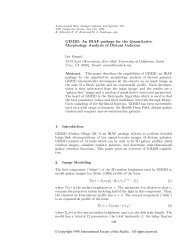4 Comparison of the ALMA and Herschel - ESO
4 Comparison of the ALMA and Herschel - ESO
4 Comparison of the ALMA and Herschel - ESO
You also want an ePaper? Increase the reach of your titles
YUMPU automatically turns print PDFs into web optimized ePapers that Google loves.
DRSP 4.1.3, Chemistry in <strong>the</strong> atmospheres <strong>of</strong> Venus <strong>and</strong> Mars, is a proposal to search for <strong>and</strong> <strong>the</strong>n<br />
image mm/sub-mm spectral lines <strong>of</strong> molecules such as SO 2<br />
, H 2<br />
S, HCl, 16 O 18 O, H 2<br />
CO, H 2<br />
O 2<br />
<strong>and</strong><br />
NO. This will require 92 hours, <strong>and</strong> should be repeated two years later for <strong>the</strong> purpose <strong>of</strong> monitoring.<br />
There is an additional DRSP, 4.1.2, to study HDO from Mars. In DRSP 4.1.4, it is proposed<br />
to study <strong>the</strong> stratospheres <strong>of</strong> <strong>the</strong> giant planets in lines <strong>of</strong> CO, HCN, CS, HC 3<br />
N <strong>and</strong> HDO. There<br />
would also be blind searches; in all, this would require 154 hours. In DRSP contribution 4.1.8,<br />
it is proposed to measure <strong>the</strong> atmospheres <strong>of</strong> Triton <strong>and</strong> Pluto in spectral lines, <strong>and</strong> DRSP 4.2.1<br />
proposes to study <strong>the</strong> albedos sizes <strong>and</strong> surface properties <strong>of</strong> transneptunian objects.<br />
6.9.4 Modelling <strong>and</strong> Analysis <strong>of</strong> <strong>the</strong> Data<br />
The data sets that will be produced by <strong>ALMA</strong> <strong>and</strong> <strong>Herschel</strong> will be so large that <strong>the</strong> analysis<br />
<strong>and</strong> comparisons with models will have to be streamlined <strong>and</strong> automated as much as possible.<br />
Various groups around <strong>the</strong> world have started to address this issue <strong>and</strong> substantial<br />
progress is being made.<br />
For molecular clouds, chemical abundances <strong>and</strong> physical parameters have been derived<br />
traditionally using simple tools, such as rotation diagrams assuming a constant excitation<br />
temperature T ex<br />
or statistical equilibrium calculations using an escape probability approximation<br />
model for a single temperature, T, <strong>and</strong> density, n. In both cases, comparison with a<br />
“st<strong>and</strong>ard” molecule such as CO is needed to derive <strong>the</strong> abundance with respect to H 2<br />
. It is<br />
well-known that this method can lead to abundances that are in error by more than an order<br />
<strong>of</strong> magnitude. For example, <strong>the</strong> use <strong>of</strong> n = 10 5 versus 10 6 cm -3 for <strong>the</strong> interpretation <strong>of</strong> <strong>the</strong><br />
HCN J = 4-3 line with a critical density, n*, <strong>of</strong> ~10 7 cm -3 gives a factor <strong>of</strong> 10 difference in<br />
derived HCN abundance. Densities are known to range from 10 4 to >10 7 cm -3 across starforming<br />
regions. Also <strong>the</strong> neglect <strong>of</strong> beam dilution <strong>and</strong> optical depth effects can result in<br />
large errors. For example, <strong>the</strong> emission from <strong>the</strong> complex organic molecules may originate<br />
in a region <strong>of</strong> only 1”, much smaller than <strong>the</strong> observational single-dish beam <strong>of</strong> >15” which<br />
applies to <strong>the</strong> more extended CO.<br />
42




